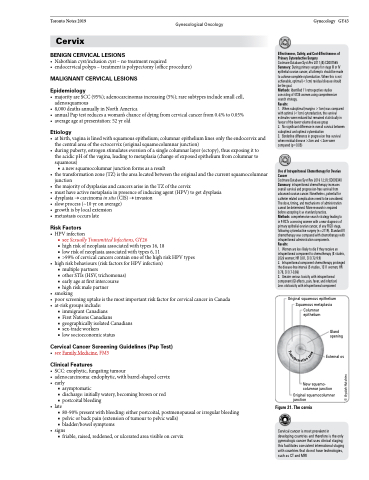Page 529 - TNFlipTest
P. 529
Toronto Notes 2019
Gynecological Oncology
Gynecology GY43
Cervix
BENIGN CERVICAL LESIONS
• Nabothiancyst/inclusioncyst–notreatmentrequired
• endocervicalpolyps–treatmentispolypectomy(officeprocedure)
MALIGNANT CERVICAL LESIONS
Epidemiology
• majorityareSCC(95%);adenocarcinomasincreasing(5%);raresubtypesincludesmallcell, adenosquamous
• 8,000 deaths annually in North America
• annualPaptestreducesawoman’schanceofdyingfromcervicalcancerfrom0.4%to0.05%
• averageageatpresentation:52yrold
Etiology
• atbirth,vaginaislinedwithsquamousepithelium;columnarepitheliumlinesonlytheendocervixand the central area of the ectocervix (original squamocolumnar junction)
• duringpuberty,estrogenstimulateseversionofasinglecolumnarlayer(ectopy),thusexposingitto the acidic pH of the vagina, leading to metaplasia (change of exposed epithelium from columnar to squamous)
■ a new squamocolumnar junction forms as a result
• thetransformationzone(TZ)isthearealocatedbetweentheoriginalandthecurrentsquamocolumnar
junction
• themajorityofdysplasiasandcancersariseintheTZofthecervix
• musthaveactivemetaplasiainpresenceofinducingagent(HPV)togetdysplasia
• dysplasia → carcinoma in situ (CIS) → invasion
• slowprocess(~10yronaverage)
• growthisbylocalextension
• metastasis occurs late
Risk Factors
• HPVinfection
■ see Sexually Transmitted Infections, GY26
■ high risk of neoplasia associated with types 16, 18
■ low risk of neoplasia associated with types 6, 11
■ >99% of cervical cancers contain one of the high risk HPV types
• highriskbehaviours(riskfactorsforHPVinfection) ■ multiple partners
■ other STIs (HSV, trichomonas)
■ early age at first intercourse
■ high risk male partner • smoking
• poorscreeninguptakeisthemostimportantriskfactorforcervicalcancerinCanada • at-riskgroupsinclude:
■ immigrant Canadians
■ First Nations Canadians
■ geographically isolated Canadians ■ sex-trade workers
■ lowsocioeconomicstatus
Cervical Cancer Screening Guidelines (Pap Test)
• seeFamilyMedicine,FM5
Clinical Features
• SCC:exophytic,fungatingtumour
• adenocarcinoma:endophytic,withbarrel-shapedcervix • early
■ asymptomatic
■ discharge: initially watery, becoming brown or red ■ postcoital bleeding
• late
■ 80-90% present with bleeding: either postcoital, postmenopausal or irregular bleeding ■ pelvic or back pain (extension of tumour to pelvic walls)
■ bladder/bowel symptoms
• signs
■ friable, raised, reddened, or ulcerated area visible on cervix
Effectiveness, Safety, and Cost-Effectiveness of Primary Cytoreductive Surgery
Cochrane Database Syst Rev 2011;(8):CD007565 Summary: During primary surgery for stage III or IV epithelial ovarian cancer, all attempts should be made to achieve complete cytoreduction. When this is not achievable, optimal (<1cm) residual disease should be the goal.
Methods: Identified 11 retrospective studies consisting of 4735 women using comprehensive search strategy.
Results:
1. Whensuboptimal(margins>1cm)wascompared with optimal (<1cm) cytoreduction, the survival estimates were reduced but remained statistically in favour of the lower volume disease group
2. Nosignificantdifferenceinoverallsurvivalbetween suboptimal and optimal cytoreduction
3. Borderlinedifferenceinprogressionfreesurvival when residual disease >2cm and <2cm were compared (p=0.05)
Use of Intraperitoneal Chemotherapy for Ovarian Cancer
Cochrane Database Syst Rev 2016 12;(1):CD005340 Summary: intraperitoneal chemotherapy increases overall survival and progression-free survival from advanced ovarian cancer. Nonetheless, potential for catheter related complications need to be considered. The dose, timing, and mechanisms of administration cannot be determined. More research is required before accepting it as standard practice.
Methods: comprehensive search strategy leading to in 9 RCTs assessing women with a new diagnosis of primary epithelial ovarian cancer, of any FIGO stage, following cytoreductive surgery (n=2119). Standard IV chemotherapy was compared with chemotherapy with intraperitoneal administration components.
Results:
1. Womenarelesslikelytodieiftheyreceivean intraperitoneal component to chemotherapy (8 studeis, 2026 women; HR 0.81, CI 0.72-9.9)
2. Intraperitonealcomponentchemotherapyprolonged the disease-free interval (5 studies, 1311 women; HR 0.78, CI 0.7-0.86)
3. Greaterserioustoxicitywithintraperitoneal component (GI effects, pain, fever, and infection) Less ototoxicity with intraperitoneal component
Original squamous epithelium Squamous metaplasia
Columnar epithelium
Gland opening
External os
New squamo- columnar junction
Original squamocolumnar junction
Figure 21. The cervix
Cervical cancer is most prevalent in developing countries and therefore is the only gynecologic cancer that uses clinical staging; this facilitates consistent international staging with countries that do not have technologies, such as CT and MRI
T
e
r
n
a
o
z
n
n
o
i
t
a
s
f
o
r
m
© Ayalah Hutchins


